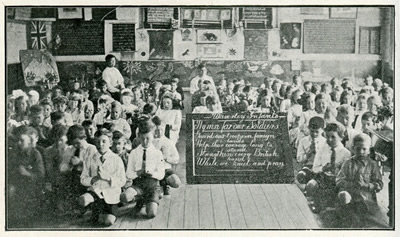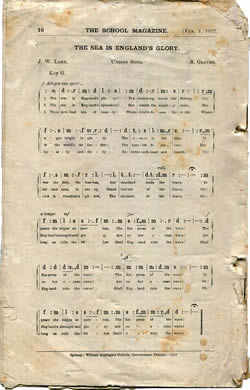Music Stage 1
Overview

Waverley Infants School assembly, a verse of 'Hymn for our Soldiers' is written on the blackboard (The Education Gazette, 1 April 1918)
©Department of Education (NSW Schoolhouse Museum of Public Education collection)
Students sing patriotic songs from the First World War. They compose and play percussion accompaniments to the songs.
Teaching and learning activities

The Sea is England's Glory (The School Magazine, Part 1, 1 February 1917)
©Department of Education (NSW Schoolhouse Museum of Public Education collection)
What patriotic songs were sung during the First World War?
During the First World War schools held daily or weekly assemblies that built pride in Australia’s contribution to the war and to the British Empire.
Learn to sing First World War songs such as Pack Up Your Troubles and The Sea is England’s Glory.
Compose and play percussion accompaniment using traditional or graphic notation for First World War songs.
Arrange patriotic songs into a rap, jazz or pop style.
Resources:
Learning concepts
These additional questions can be used for discussion or further investigations.
Caring
How did patriotic songs show that communities cared about soldiers and other service personnel?
Community
Why did school children and communities sing patriotic songs during the First World War?
Syllabus links
MUS1.1 Sings, plays and moves to a range of music, demonstrating an awareness of musical concepts.
MUS1.2 Explores, creates, selects and organises sound in simple structures.
MUS1.4 Responds to a range of music, expressing likes and dislikes and the reasons for these choices.